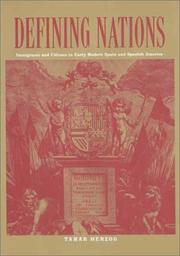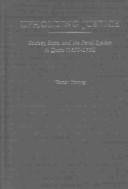| Listing 1 - 10 of 22 | << page >> |
Sort by
|

ISBN: 0300092539 Year: 2003 Publisher: New Haven, Conn. Yale University Press
Abstract | Keywords | Export | Availability | Bookmark
 Loading...
Loading...Choose an application
- Reference Manager
- EndNote
- RefWorks (Direct export to RefWorks)
Herzog explores the emergence of a specifically Spanish concept of community in both Spain & Spanish America in the 18th century. Her argument is that the distinction between Spaniards & others had less to do with ethnicity than with a willingness to take on the duties of membership of the community.
Citizenship --- Colonies --- History --- History of Latin America --- History of Spain --- anno 1700-1799 --- 323.2 --- 946.05 --- 980.03 =6 --- 323.2 Burgerbevolking in relatie tot de staat. Burger en staat --- Burgerbevolking in relatie tot de staat. Burger en staat --- 980.03 =6 Geschiedenis van Latijns-Amerika:--onafhankelijkheid, tot 1900 --- Geschiedenis van Latijns-Amerika:--onafhankelijkheid, tot 1900 --- 946.05 Geschiedenis van Spanje: Habsburgers en Bourbons--(1598-1808) --- Geschiedenis van Spanje: Habsburgers en Bourbons--(1598-1808) --- Birthright citizenship --- Citizenship (International law) --- National citizenship --- Nationality (Citizenship) --- Political science --- Public law --- Allegiance --- Civics --- Domicile --- Political rights --- Law and legislation --- Spain --- Espanja --- Spanien --- Hiszpania --- Spanish State --- España --- Estado Español --- Espagne --- Hispania --- Sefarad --- Sepharad --- Shpanye --- Shpanie --- Reino de España --- Kingdom of Spain --- Reino d'Espanya --- Reinu d'España --- Espainiako Erresuma --- Regne d'Espanya --- Reiaume d'Espanha --- Espanya --- Espanha --- スペイン --- Supein --- イスパニア --- Isupania
Book
ISBN: 9780674735385 0674735382 Year: 2015 Publisher: Cambridge: Harvard university press,
Abstract | Keywords | Export | Availability | Bookmark
 Loading...
Loading...Choose an application
- Reference Manager
- EndNote
- RefWorks (Direct export to RefWorks)
"Frontiers of Possession asks how territorial borders were established in Europe and the Americas during the early modern period and challenges the standard view that national boundaries are largely determined by military conflicts and treaties. Focusing on Spanish and Portuguese claims in the New and Old Worlds, Tamar Herzog reconstructs the different ways land rights were negotiated and enforced, sometimes violently, among people who remembered old possessions or envisioned new ones: farmers and nobles, clergymen and missionaries, settlers and indigenous peoples. Questioning the habitual narrative that sees the Americas as a logical extension of the Old World, Herzog portrays Spain and Portugal on both sides of the Atlantic as one unified imperial space. She begins in the Americas, where Iberian conquerors had to decide who could settle the land, who could harvest fruit and cut timber, and who had river rights for travel and trade. The presence of indigenous peoples as enemies to vanquish or allies to befriend, along with the vastness of the land, complicated the picture, as did the promise of unlimited wealth. In Europe, meanwhile, the formation and re-formation of boundaries could last centuries, as ancient entitlements clashed with evolving economic conditions and changing political views and juridical doctrines regarding how land could be acquired and maintained. Herzog demonstrates that the same fundamental questions had to be addressed in Europe and in the Americas. Territorial control was always subject to negotiation, as neighbors and outsiders, in their quotidian interactions, carved out and defended new frontiers of possession."--Publisher's description.
Spain --- Imperialism --- Expansionspolitik. --- Grenzkonflikt. --- Diplomatiska förbindelser --- Gränser --- Kolonier --- Diplomatic relations. --- Imperialism. --- Portuguese colonies. --- Spanish colonies. --- Territorial expansion. --- Colonies --- History. --- historia. --- Portugal --- Portugal. --- Spanien. --- Südamerika. --- America. --- Spain. --- Foreign relations. --- Territorial expansion --- Espagne --- --Portugal --- --Relations extérieures --- --Histoire des relations internationales --- --Amérique --- --Colonie --- --Frontière --- --Amérique du Sud --- --Expansion territoriale --- --Colonies --- History --- Foreign relations --- Relations extérieures --- Histoire des relations internationales --- Colonie --- Frontière --- Expansion territoriale --- Amérique --- Amérique du Sud

ISBN: 3465028805 9783465028802 Year: 1996 Volume: 82 Publisher: Frankfurt a. M.: Klostermann,
Abstract | Keywords | Export | Availability | Bookmark
 Loading...
Loading...Choose an application
- Reference Manager
- EndNote
- RefWorks (Direct export to RefWorks)
Book
ISBN: 9780674980341 0674980344 0674981758 Year: 2018 Publisher: Cambridge, Massachusetts ; London, England : Harvard University Press,
Abstract | Keywords | Export | Availability | Bookmark
 Loading...
Loading...Choose an application
- Reference Manager
- EndNote
- RefWorks (Direct export to RefWorks)
"Tamar Herzog offers a road map to European law across 2,500 years that reveals underlying patterns and unexpected connections. By showing what European law was, where its iterations were found, who made and implemented it, and what the results were, she ties legal norms to their historical circumstances and reveals the law's fragile malleability"--
Civil law systems --- Common law --- Law --- History. --- History --- International unification --- Acts, Legislative --- Enactments, Legislative --- Laws (Statutes) --- Legislative acts --- Legislative enactments --- Jurisprudence --- Legislation --- Roman law --- International unification&delete& --- Influence

ISBN: 1281722278 9786611722272 0300129831 9780300129830 9781281722270 0300092539 9780300092530 6611722270 Year: 2003 Publisher: New Haven Yale University Press
Abstract | Keywords | Export | Availability | Bookmark
 Loading...
Loading...Choose an application
- Reference Manager
- EndNote
- RefWorks (Direct export to RefWorks)
In this book Tamar Herzog explores the emergence of a specifically Spanish concept of community in both Spain and Spanish America in the eighteenth century. Challenging the assumption that communities were the natural result of common factors such as language or religion, or that they were artificially imagined, Herzog reexamines early modern categories of belonging. She argues that the distinction between those who were Spaniards and those who were foreigners came about as local communities distinguished between immigrants who were judged to be willing to take on the rights and duties of membership in that community and those who were not.
Citizenship --- Birthright citizenship --- Citizenship (International law) --- National citizenship --- Nationality (Citizenship) --- Political science --- Public law --- Allegiance --- Civics --- Domicile --- Political rights --- History --- Colonies --- Law and legislation --- Spain --- Espagne --- Espainiako Erresuma --- España --- Espanha --- Espanja --- Espanya --- Estado Español --- Hispania --- Hiszpania --- Isupania --- Kingdom of Spain --- Regne d'Espanya --- Reiaume d'Espanha --- Reino de España --- Reino d'Espanya --- Reinu d'España --- Sefarad --- Sepharad --- Shpanie --- Shpanye --- Spanien --- Spanish State --- Supein --- イスパニア --- スペイン

ISBN: 0472113755 9780472113750 Year: 2007 Publisher: Ann Arbor: University of Michigan press,
Abstract | Keywords | Export | Availability | Bookmark
 Loading...
Loading...Choose an application
- Reference Manager
- EndNote
- RefWorks (Direct export to RefWorks)
History of Latin America --- anno 1600-1699 --- anno 1700-1799 --- Quito --- Criminal justice, Administration of --- History --- Administration of criminal justice --- Justice, Administration of --- Crime --- Criminal law --- Criminals --- Law and legislation --- Criminal justice, Administration of - Ecuador - Quito - History - 17th century --- Criminal justice, Administration of - Ecuador - Quito - History - 18th century
Book
ISBN: 0674745183 0674735803 9780674735804 0674735382 9780674735385 9780674745186 Year: 2015 Publisher: Cambridge, MA : Harvard University Press,
Abstract | Keywords | Export | Availability | Bookmark
 Loading...
Loading...Choose an application
- Reference Manager
- EndNote
- RefWorks (Direct export to RefWorks)
Frontiers of Possession asks how territorial borders were established in Europe and the Americas during the early modern period and challenges the standard view that national boundaries are largely determined by military conflicts and treaties. Focusing on Spanish and Portuguese claims in the New and Old Worlds, Tamar Herzog reconstructs the different ways land rights were negotiated and enforced, sometimes violently, among people who remembered old possessions or envisioned new ones: farmers and nobles, clergymen and missionaries, settlers and indigenous peoples. Questioning the habitual narrative that sees the Americas as a logical extension of the Old World, Herzog portrays Spain and Portugal on both sides of the Atlantic as one unified imperial space. She begins in the Americas, where Iberian conquerors had to decide who could settle the land, who could harvest fruit and cut timber, and who had river rights for travel and trade. The presence of indigenous peoples as enemies to vanquish or allies to befriend, along with the vastness of the land, complicated the picture, as did the promise of unlimited wealth. In Europe, meanwhile, the formation and re-formation of boundaries could last centuries, as ancient entitlements clashed with evolving economic conditions and changing political views and juridical doctrines regarding how land could be acquired and maintained. Herzog demonstrates that the same fundamental questions had to be addressed in Europe and in the Americas. Territorial control was always subject to negotiation, as neighbors and outsiders, in their "idian interactions, carved out and defended new frontiers of possession.
Imperialism --- History. --- Spain --- Portugal --- al-Burtughāl --- al-Jumhūrīyah al-Burtughālīyah --- Burtughāl --- Jumhūrī-i Purtughāl --- Jumhūrīyah al-Burtughālīyah --- Lusitania (Portugal) --- Portekiz --- Portekiz Cumhuriyeti --- Portogalia --- Portogallo --- Portugál Köztársaság --- Portugali --- Portugalia --- Portugalii︠a︡ --- Portugalská republika --- Portugalʹskai︠a︡ Respublika --- Portugalsko --- Portugiesische Republik --- Portuguese Republic --- Porutogaru --- Porutogaru Kyōwakoku --- P'orŭt'ugal --- P'orŭt'ugal Konghwaguk --- Purtughāl --- Putaoya --- Putaoya Gongheguo --- Repubblica Portoghese --- Republica Portugheză --- República Portuguesa --- Republika Portugalska --- République portugaise --- Sefarad --- Португальская Республика --- Португалия --- פורטוגל --- البرتغال --- الجمهورية البرتغالية --- برتغال --- جمهوري پرتغال --- جمهورية البرتغالية --- پرتغال --- ポルトガル --- ポルトガル共和国 --- 葡萄牙 --- 葡萄牙共和国 --- 포르투갈 --- 포르투갈공화국 --- Espagne --- Espainiako Erresuma --- España --- Espanha --- Espanja --- Espanya --- Estado Español --- Hispania --- Hiszpania --- Isupania --- Kingdom of Spain --- Regne d'Espanya --- Reiaume d'Espanha --- Reino de España --- Reino d'Espanya --- Reinu d'España --- Sepharad --- Shpanie --- Shpanye --- Spanien --- Spanish State --- Supein --- イスパニア --- スペイン --- Foreign relations. --- Territorial expansion --- Spain - Colonies - America - History --- Imperialism - History --- Relations extérieures --- Histoire des relations internationales --- Colonie --- Frontière --- Expansion territoriale --- Amérique --- Amérique du Sud --- Spain - Foreign relations --- Spain - Territorial expansion - History --- Portugal - Foreign relations --- Portugal - Territorial expansion - History --- Portugal - Colonies - America - History
Book
ISBN: 9780674237865 Year: 2019 Publisher: Cambridge, Massachusetts : Harvard University Press,
Abstract | Keywords | Export | Availability | Bookmark
 Loading...
Loading...Choose an application
- Reference Manager
- EndNote
- RefWorks (Direct export to RefWorks)
Law --- Roman law. --- Common law --- Civil law --- History.
Book
ISBN: 0674981758 9780674981751 9780674980341 0674980344 Year: 2018 Publisher: Cambridge, Massachusetts
Abstract | Keywords | Export | Availability | Bookmark
 Loading...
Loading...Choose an application
- Reference Manager
- EndNote
- RefWorks (Direct export to RefWorks)
"Tamar Herzog offers a road map to European law across 2,500 years that reveals underlying patterns and unexpected connections. By showing what European law was, where its iterations were found, who made and implemented it, and what the results were, she ties legal norms to their historical circumstances and reveals the law's fragile malleability"--
Law --- Common law --- Civil law systems --- Law --- History. --- History. --- History. --- International unification --- History.
Book
ISBN: 9780674981744 Year: 2018 Publisher: Cambridge, MA
Abstract | Keywords | Export | Availability | Bookmark
 Loading...
Loading...Choose an application
- Reference Manager
- EndNote
- RefWorks (Direct export to RefWorks)
| Listing 1 - 10 of 22 | << page >> |
Sort by
|

 Search
Search Feedback
Feedback About UniCat
About UniCat  Help
Help News
News